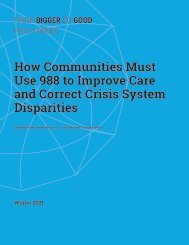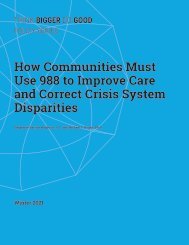Scattergood_IMD_Web
You also want an ePaper? Increase the reach of your titles
YUMPU automatically turns print PDFs into web optimized ePapers that Google loves.
3 Gaps in Care<br />
Still Exist for<br />
Some Medicaid<br />
Beneficiaries<br />
The litany of complaints about gaps in care for persons with mental illnesses does not<br />
begin and end with the <strong>IMD</strong> rule, but several care shortcomings related to capacity<br />
constraints are linked to the rule—in particular, over-reliance on less appropriate care<br />
in emergency departments (EDs) and unspecialized beds in general hospitals. Recent<br />
evidence indicates that too much of America’s mental health care occurs in EDs<br />
and non-specialized beds distributed across hospitals (known as “scatter beds”), rather<br />
than in psychiatric units of hospitals or in <strong>IMD</strong>s. Research conducted for the Substance<br />
Abuse and Mental Health Services Administration estimated that scatter beds account<br />
for 36% of general hospital mental health expenditures (6), and an American College<br />
of Emergency Physicians (ACEP) survey of ED medical directors found that 81%<br />
believed that dedicated emergency psychiatric facilities would improve care (7). For<br />
persons whose care requires a hospital admission, scatter beds cannot provide the<br />
specialized treatment required—and provided—by psychiatric hospitals.<br />
Furthermore, reliance on EDs for mental health crises has increased. A 2016 study by<br />
the Agency for Healthcare Research and Quality found that from 2006 to 2013, ED<br />
visits per capita increased 52% for psychoses or bipolar disorder and 37% for substance<br />
use disorders (8). Many of these visits are preventable. In 2014, 30-day all-cause<br />
readmission rates after hospitalization for schizophrenia and other psychiatric<br />
disorders were 15.8% among the privately insured but 24.9% among those with Medicaid (9).<br />
Medicaid beneficiaries have higher readmissions rates than individuals with private<br />
insurance across all hospitalizations, but the gap is nearly twice as wide for mental<br />
health admissions (10).<br />
Medicaid’s Institutions for Mental Diseases (<strong>IMD</strong>) Exclusion Rule: A Policy Debate 28

















